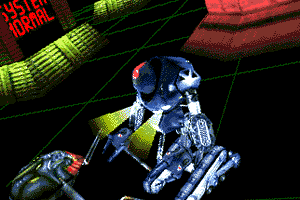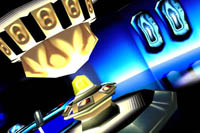3D Animation Workshop: Lesson 43: Cutting Edge VRML | 2
|
|
|
Lesson 43 - Cutting Edge VRML - Part 3
The power that Java programming adds to VRML is most evident in the games that Shout has designed and implemented for Web content. Jim Stewartson, Shout's programming dynamo, tends to think more in terms of what VRML does for Java, than what Java does for VRML.
"To me, VRML by itself is simply a very convenient way of rendering 3D graphics and animation in a Web browser. While there is still a real "wow" factor provided by navigating around in 3D environments, watching animations, and manipulating 3D objects, this is quickly supplanted by a question: 'Cool, but what does it do?'"While VRML has made great strides in terms of providing built-in interactivity since VRML 1.0, it is still very difficult to do much more than create glorified "museum" spaces in VRML without adding a genuine programming language to the recipe. Of course, on the Web, Java is effectively the only solution to this challenge and one that is remarkably well suited for it.
"One stumbling block to popularizing VRML with and without Java is that so far VRML content has been largely self-referential. By this I mean that most VRML "worlds" don't represent much more than the fact that they are created in VRML, and don't do much more than demonstrate the capabilities of VRML. ("Look, Ma! I made a spinning cube! In VRML!") This is natural for a young technology, but for it to mature and become popular, it needs to be applied to areas which people other than technologists find useful or interesting."
Making VRML work commercially has got to include making games, not only because they are very popular content, but also because they define the standards of interactivity. Many people might assume (as I did) that VRML could not be competitive with other 3D technologies for games, but according to Jim, "It depends on how you compare them."
"For example, if you make a straight rendering speed and quality comparison of a VRML plug-in in a web browser over a 14.4 modem to ID's Quake engine reading off a CD-ROM, you will quickly see that VRML does not compare very favorably. If, however, you make a comparison between cost, ease of authoring, and--most importantly--distribution, VRML wins hands down."Of course, there is a very clear analogy to be made here to the performance difference between Java and native code. Yes, native code is faster, but it is also comparatively difficult to author and to distribute."
Shout's VRML games perform without apologies or excuses. If you haven't done so already, head back to the VW Beetle game that is reached by entering into the car (using the arrow icon) and then clicking on the "key" icon that appears. You'll pass through some explanatory material before the game is loaded in a separate window. Then start playing.

Shout's most impressive games thus far have been the ones developed for the "Lost in Space" promotional site (for which we already saw the banner ads.
The graphical look is rich and the interaction is very sophisticated. These are real computer games that one can spend some serious time with. And they run at very respectable speeds on today's lowest-price Pentium systems. A key element to making these games efficient is Java programming that intelligently eliminates (culls) geometry from the scene if it is not visible from the use's current viewpoint. Jim Stewartson has perfected this technique.


Click on either of the two images above to visit the Lost in Space site. Once there, click through to the "3D Game." And have some fun.
Next time, we'll take a look at even more of Shout's cutting-edge work.
| To Return to Parts 1 and 2, Use Arrow Buttons |
|
|
Comments are
welcome
and brought to you by webreference.com
Created: June 24, 1998
Revised: June 24, 1998
URL: https://webreference.com/3d/lesson43/part3.html


 Find a programming school near you
Find a programming school near you